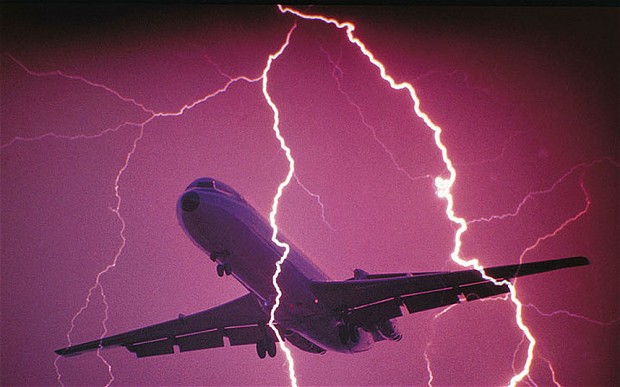How bad weather can affect aircraft, and what can be done: Q&A

By Bloomberg
As search and rescue crews start retrieving wreckage and bodies from AirAsia Bhd. flight QZ8501 in the Java Sea, the role of weather will be among the dozens of factors investigators study to determine what led to the crash of the Airbus Group NV A320 single-aisle jet.
The following questions and answers address some of the issues related to weather and aviation.
*Do we know what role weather played in AirAsia Flight QZ8501?
Investigators have not yet been able to say what role weather played in QZ8501. The pilot had asked to change the route due to weather, a normal procedure when an aircraft’s flight may put it on a path to face heavy weather including turbulence or thunderstorms.
“The fact that the pilot asked for a change of course -- the deviation around the weather -- is perfectly normal,” said Dave Smith, a former pilot for British Airways and a member of the British Airline Pilots Association. “The weather itself should not have caused what apparently is a catastrophic accident.”
*How can weather affect aircraft?
Wind, more than rain, directly affects how an aircraft flies because lift is created by the movement of air over the wings. Shifts in air pressure, wind speed or direction can impact how much lift is created with sudden changes being capable of forcing an aircraft to rise or fall suddenly.
*How does altitude affect flight performance and safety?
Higher altitudes bring multiple challenges, including thinner air and lower temperatures, which can reduce an aircraft’s performance.
At higher altitudes aircraft engines are less efficient due to the decreased density of the air, while lift created over the wings is also lower.
Higher altitudes can also increase the possibility of ice formation either on the wings, which can limit the aircraft’s ability to produce lift, or on sensors which track airspeed and altitude. Higher altitude air is also harder to breathe, which is why aircraft are pressurized.
While thunderstorms do cause lightning, serious accidents due to lightning strikes are extremely rare.
*What kind of weather can cause problems for aircraft?
Modern commercial jets are able to handle a large range of weather conditions. Thunderstorms and tall clouds called cumulonimbus are among the most risky weather patterns that pilots may face. They can stretch as high as 60,000 feet, well above the ceiling altitude of most commercial aircraft.
Thunderstorms can form quickly, reaching their peak strength within 15 minutes, and usually occur as air warms up creating rising air currents that become extremely turbulent. After reaching maturity, a thunderstorm will start shedding the moisture it absorbed, forming rain or hail and strong downdrafts.
An aircraft entering a thunderstorm could experience updrafts or downdrafts exceeding 3,000 feet per minute. Changes in air pressure and temperature inside a thunderstorm can also lead to icing.
*What technologies are available to track or avoid bad weather?
Satellites, weather balloons and ground radar have been used to both forecast future weather and update current conditions for decades. Ground-based weather radars transmit a signal, then detect and analyze the returning echo to assess the size and concentration of water droplets as well as wind speed.
Because weather patterns can form and dissipate quickly, and weather analysis can be difficult at longer distances, aircraft are being increasingly equipped with on-board systems called Airborne Weather Avoidance Radar.
While AWAR is useful for a pilot to get nearby weather information, it is also limited in both the direction and range at which it can detect wind or rain.
In addition to weather detection and avoidance technology, communications systems are a key tool for pilots to receive and share information.
Aircraft Communications Addressing and Reporting System, or ACARS, is a data-based system that avoids the need for information to be relayed by voice. In addition to aircraft data such as fuel and location, ACARS can be equipped to include weather data.
*Can good equipment allow a pilot to fly through thunderstorms?
On-board AWAR systems are designed to allow pilots to avoid severe weather, not fly through it. The U.S. FAA recommends pilots avoid heavy weather by at least 20 miles.
“Weather recognizable as a thunderstorm should be considered hazardous, as penetration of any thunderstorm can lead to an aircraft accident and fatalities to those on board,” the FAA advises.
“Our primary aim as pilots is to get passengers safely back on the ground and the secondary aim is to give them the smoothest and most comfortable ride possible,” said Captain Smith. “So even if the plane can physically fly through these clouds -- not the very center, but around the edges -- we always try to avoid getting anywhere near them just to keep it as smooth as possible.”
Here we are to serve you with news right now. It does not cost much, but worth your attention.
Choose to support open, independent, quality journalism and subscribe on a monthly basis.
By subscribing to our online newspaper, you can have full digital access to all news, analysis, and much more.
You can also follow AzerNEWS on Twitter @AzerNewsAz or Facebook @AzerNewsNewspaper
Thank you!
